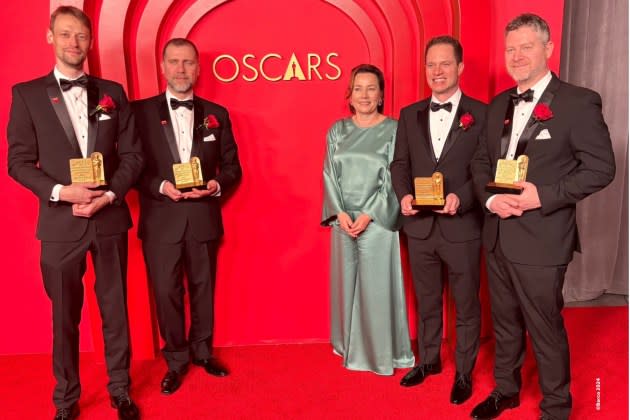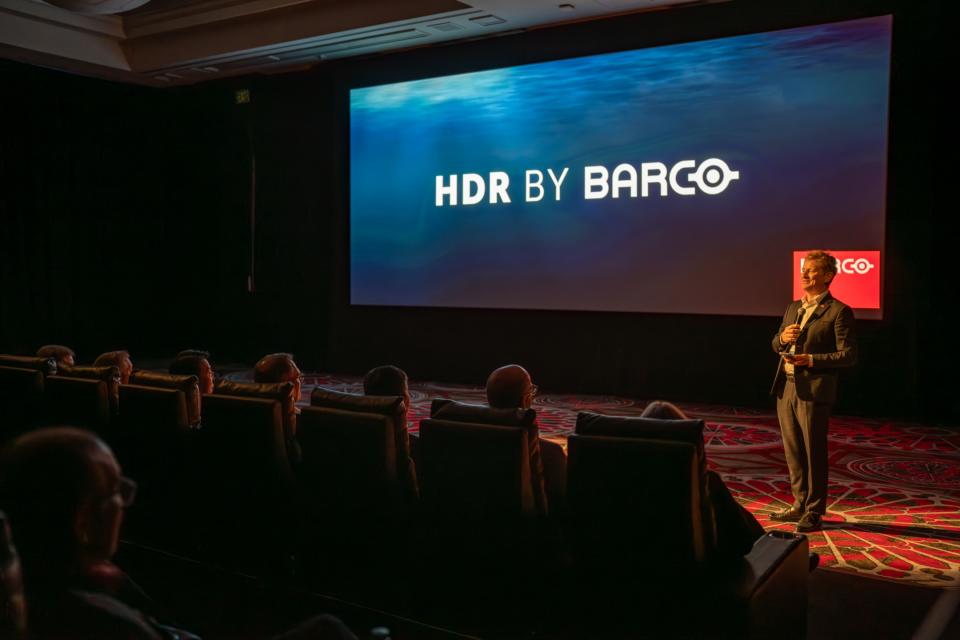From Laser Projection to HDR, Barco Lights Up the Film Business

This past February, an unconventional delegation from Barco made the trek from Ghent to Los Angeles. Clad in bowties and evening gowns, this crew of execs and engineers cut dashing figures on a Hollywood red carpet, striding into an AMPAS Scientific and Technical Awards ceremony that saw the team honored for their pioneering work reshaping the global film business.
The accolades arrived at an auspicious moment for Belgian manufacturer, as the optical imaging specialist now celebrates its 90th anniversary while seeing its imprint on the film world ever expand.
More from Variety
Indeed, that cinematic impact is all the more notable for its relative recency. Founded by Flemish entrepreneur Lucien De Puydt in 1934, the Belgian American Radio Corporation (Barco) first emerged as an audio purveyor, quickly dominating the European market with radios and then jukeboxes sold under the slogan of “‘Your family’s indispensable friend.”
Such goodwill paved the way for television receivers – initially notable for their abilities to capture far-ranging feeds, and then for the introduction of Europe’s first remote control a generation later – before leading to video projection in the 1970s. After assuring such technology on in-flight entertainment systems, Barco next expanded to hospitals and boardrooms, becoming so prevalent in the latter sphere that the brand itself became Gallic shorthand for conference room tech.
And then, at the turn of the millennium, Barco looked to the big screen.
“Back then, projection technology was really at a bottleneck,” says Barco director of cinema technology Tom Bert. “It was based on analog film rolls and we didn’t deal with that. Instead, Barco had developed digital projection methods in the 1980s, and we wanted to use that as a runway to cinema, to help the film business make a similar leap.”
In 1999, Barco’s nascent exhibition curiosity found an early source of inspiration in George Lucas, doing so at the exact moment when the film pioneer was rolling out his first, innovative “Star Wars” prequel.
“Visionaries like Lucas planted the seed,” says Bert. “He saw so many digital opportunities, and that rippled down to companies like ours. We thought to ourselves, how could we make those same digital building blocks work for cinema exhibition? Because a film projector needs to bring a greater brightness and higher resolution to the screen, and we needed to show that a digital projector could do that.”
That year, Barco introduced the DP50 digital projector. And, as in so many fields, at first the skeptics vastly outnumbered the early-adopters.

“Whenever you present something new to an industry that had followed the same standard for a century you’re bound to receive doubt and hesitancy,” says Bert. “But all those critical eyes looking for imperfections had to admit there was no visible difference, no downsides or imperfections. The movies looked just as great. And once they got over that hurdle, the next question was one of investment and adoption.”
In the ensuing decade, the hook of Barco’s pitch segued from technical to financial, finding greater and greater purchase with legacy partners who recognized the economies of this new approach.
“The studios incentivized exhibitors to convert to digital, because doing so would make the whole distribution flow more efficient,” says Bert. “In the old world, studios had to create thousands of film rolls and then send these around the world, which was a very expensive process. In the digital world, they could just send a file, so they saw the potential and tried to accelerate conversion by offering exhibitors financial incentives.’
“And having a reliable product that just works was very convincing as well,” he adds.
The early 2000s saw slow-and-steady innovation, as the Barco team developed a portfolio of devices for varied use (“we could now offer a wide suite of products,” says Bert, “and not onesies and twosies”) while studios continued to incentivize the digital leap. And all the while, another blockbuster visionary was cooking up something that would draw unparalleled attention to Belgium.
“[The 2009 release of] ‘Avatar’ changed everything,” says Bert. “Everyone wanted to see it in 3D, and for that you need digital. So that’s when the industry en masse made the shift, dropping analogue and asking us to send them projectors as soon as possible. And that’s when the frenzy kicked off.”
Within two years, Barco factories were running on three additional shifts while international clients angled for priority expedition. This breakneck industry conversation made Barco the clear market leader, with Belgian company deploying more than 100,000 devices since 2008. Today, a whopping 55% of world’s cinema screens are brought to life by a Barco projector.
And all the while, the company’s engineers continued to tinker. Just as the factories were working triple time to meet global demand, the R&D labs were experimenting, seeing if lasers might replace the standard incandescent bulb as an internal light source. In 2014, the company released its first laser-backed projector; today, that is the only kind they sell.
“An industry that had been using lamps for over a century all of a sudden got access to a light source that had a lifetime of 10 years, that didn’t have the same complexities or requirements to swap regularly, and that reached an even greater brightness,” says Bert. “So it was a big achievement. And if you look today, every projector – not only those from Barco – follows that model.”
Earlier this year, engineers Peter Janssens, Goran Stojmenovik and Wouter D’Oosterlinck from Barco’s R&D team took to Los Angeles to claim Academy Scientific and Technical awards for work on the Barco RGB Laser Projector a decade before. The night was a glitzy and almost surreal affair for many of the honorees, who had much to celebrate. “We’re a European company with a both-feet-on-the-ground kind of culture,” laughs Bert. “And then you fly over to Hollywood to find yourself on the red carpet in a tuxedo… It’s not something we do every day.”
A different Barco team will be present in Cannes, where George Lucas will just so happen to receive this year’s honorary Palme d’Or for his impact on film as an art and industry. To trace those after-effects, one need only take a trip to Cannes’ Cineum multiplex, where Barco will showcase its HDR Lightsteering technology. Indeed, the company is placing its next bet on the brighter lights and darker hues of high dynamic range, hosting demos at the Asian World Film Festival, out of CinemaCon and now back to Croisette for the second year in a row.
And between such events, Barco has a five-person content team that goes out and shares the good news across Hollywood, proselytizing to creatives, colorists, directors and studio execs, and winning influential converts in the likes of Jerry Bruckheimer and Joseph Kosinski.
“HDR allows filmmakers to expand their pallets,” says Bert. “Filmmakers can use these punchier highlights and more nuanced and detailed blacks as a storytelling tool to shock or startle their audience. If you can bring more depth to the image, you can better impart emotions. Audiences can have a more immersive experiences, filmmakers can have their work presented in the best light possible, and if we can deliver that in a scalable and affordable way then it’s win-win across the board.”
“We’re not trying to build funkier projectors,” he adds. “We just want to present better movies.”

Best of Variety
Sign up for Variety’s Newsletter. For the latest news, follow us on Facebook, Twitter, and Instagram.
Solve the daily Crossword

